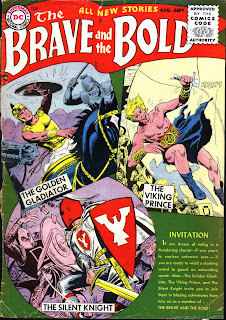But in the Silver Age, Marvel seemed to be the place where corpses got up and walked on a regular basis (especially villains), and so I thought I would try to catalog all of their examples. Of course, an undertaking like this is going to require the assistance of my readers. Although I have read virtually all of the Silver Age Marvel line, my memory's nowhere near as good as it used to be.
First up is Doctor Doom. The Lord of Latveria apparently succumbed at the end of several of his early adventures. For example:
Or:
And:
Let me point out here that there's actually a pretty good reason for the "death" ending; it saves the writers the necessity of explaining how the villain got out of jail. And Doctor Doom was, in a way copying an earlier DC villain in meeting his apparent demise at the end of many of his early meetings:
And:
This last bit, with the villain falling into water, has become something of a cliche for comic writers. It has the advantage of giving the appearance of death, combined with the uncertainty. Plus, conveniently, it doesn't really have to be explained much in the subsequent resurrection. See there was this pipe/cave nearby with a convenient air pocket....
Anyway, Dr Doom had more than his share of deaths in the early Marvel Age, so we'll skip over him. The next major villain to "die" in the FF was the Puppet Master:
He returned in FF #14 and, although he apparently bit the bullet at the end of that issue, many more times as well. One of the interesting things about that initial resurrection, though, was that Stan didn't bother to explain it. Never mind that (as shown above), we'd seen him fall out of a skyscraper. This would become the rule, rather than the exception.
I'm not sure if there are any other "deaths" in the Silver Age Fantastic Four, so let's move on to the Amazing Spiderman. The only real death and resurrection I'm aware of there involves the Vulture:
The original Vulture apparently shuffles off the mortal coil shortly after that scene, although he returns in ASM #63 to battle both Spidey and Blackie Drago, his chosen successor. I'm again not aware of any other deaths and resurrections in the Silver Age involving Spiderman, although there are some (Silvermane, for example) who died in the SA but didn't respawn until much later.
The only example of a major Marvel hero dying and not coming back for a couple of issues (a la Lightning Lad) involved Captain America. Death here from CA #111:
 Note the "falling into water" bit I mentioned earlier. Cap's resurrection came in the first issue of his magazine that I ever bought:
Note the "falling into water" bit I mentioned earlier. Cap's resurrection came in the first issue of his magazine that I ever bought:
I'm struggling now to think of resurrections involving other Marvel villains. About the only one that's coming to mind is the Rhino's passing from Hulk #104:
The Rhino would return along with the Leader to bedevil Bruce Banner's wedding in Hulk #124 as I covered awhile ago. Oh, the Leader, that's right, he died in Tales to Astonish #74:
And both the Leader and the Rhino appear to die at the end of Hulk #124, but we know better. The Black Widow had a couple of brushes with the Grim Reaper, as I have covered in the past. And I know the Unicorn appeared to die in Iron Man #4. Any more examples? I'm mostly interested in cases where the resurrection happened by the end of the Silver Age, simply because there are so many examples after that.
Updates: Some good suggestions in the comments section: The Mandarin's castle was hit by an ICBM in ToS #86:
But he returned with a reasonable explanation:
Multi-dimensional teleportation device. Don't leave home without it! The Mandarin also shuffled off the mortal coil in Avengers Annual #1:
And, as my anonymous commenter noted, he returned in the Hulk #107 with no particular explanation. MDTD, I suppose?
Titanium Man learned the fate of Silver medalists in the old Soviet Union:
But he returned ten issues later, this time apparently supported by the Red Chinese. The Red Skull drowned at the end of ToS #81, weighed down by a suit of golden armor:
He returned in ToS #89 with the explanation that the Cosmic Cube's power kept him alive. Hat tip to Nick Caputo on that one. The Red Skull biffed it again in ToS #91:
The explosion death was also popular, because it can be argued that we missed seeing something due to the flash. The Skull returned in Cap #101:
The Stilt Man shriveled up like Dr Doom up above in DD #8:
When the Leap-Frog asked him about his apparent death, Stilty was rather terse, replying, "You seem to have an uncanny knack for being wrong."
Another commenter pointed out that Magneto died in X-Men #53 and returned in X-Men #62; I can't find those issues at the moment to post panels.
Observations: One thing seems apparent; the villains who "die" on multiple occasions but return just as often tend to be Marvel's top antagonists; Dr Doom, the Mandarin, the Red Skull and the Leader are all on the short list of major baddies.
Update II: Diablo took a dirt nap thanks to his android, the Dragon Man, in FF #35:
He returned in Avengers #41, with the explanation that he owed his survival to alchemy.












_048_03.jpg)




















































